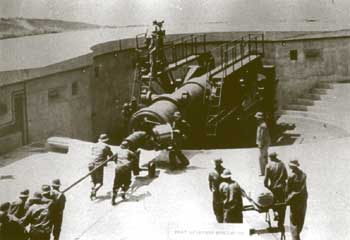|
Battery Leary-Merriam
14' Gun Battery - HDCP - HECP - Nike IFC
Battery Leary - Merriam was constructed
during the years 1916-1919 under the fortification program
outlined by the Taft Board Report of 1906. Although
constructed as a single two-gun emplacement, each gun was
originally designated as a separate tactical battery, hence
the two names. Later, the battery was considered to be a
single tactical unit.
These 14-inch disappearing guns
could fire a 1560 pound projectile fourteen miles out into
the Catalina Channel. However, full caliber
|

Battery Leary during a firing practice in
the 1920's |
|
firing
practice was rare because of the damage caused by the firing
concussions to near-by residences.
Even though the disappearing carriages of
Battery Leary-Merriam were considered to be obsolete by the
early 1920s, they remained in active service until they were
replaced by new ordnance in the mid-1940s.
In 1943, the ammunition and fire control equipment for this
battery was removed and the interior spaces were heavily
modified so the battery could be converted into the Harbor
Defense and Harbor Entrance Command Post. In 1956 Battery
Leary-Merriam underwent another conversion, this time to
serve as the Integrated Fire Control site for the NIKE
Air-Defense launch site at Whites Point. The battery
continued in this roll until the end of the NIKE program in
1976.
Today the battery is not open to the general public, and
much of the area surrounding it is off limits and is used by
the United States Coast Guard and the Southern California
Marine Exchange. This unique public-private partnership
works to provide services to ships operating in the waters
off Southern California and also serves as the maritime
equivalent of an airport control tower for the waters of the
surrounding area.
|
|
Battery Leary is named for Brigadier General Peter
Leary Jr. (ca1838-1911) Born in Maryland; Peter Leary
was a career army officer who first served with the
Baltimore, Maryland Volunteer Light Artillery during
the civil war. In 1863-1864 his unit was involved with
the campaigns at Gettysburg, and in Maryland. After
the Civil War ended, Leary joined the regular army and
participated in the 1869 war against the Arapahoe
Indians, the Modoc War of 1873, and against the Nez
Perce Indians in 1877. In 1898 he was serving with
Battery D of the US 4th Artillery when his
unit was ordered to the city off Tampa Florida to
participate in the Spanish American War. Leary and his
men were “horsed and equipped” but the war ended
before they could be sent to Cuba.
Brigadier General Peter Leary died on February 13,
1911 and is buried in the Arlington National Cemetery. |
|
Battery
Merriam is named for Major General Henry Clay Merriam
(1837-1912) a Congressional Medal of Honor recipient
for his actions against Fort Blakely Alabama during
the Civil War. At the time, he was serving as a
Lieutenant Colonel of the 73rd U.S. Colored Troops. He
was awarded his Medal on June 28, 1894. After the war,
he served in numerous expeditions and conflicts during
the Indian wars.
From 1873 to 1876 he served in the defense of US
citizens on both sides of the Rio Grande during
revolutionary uprisings. From 1900 to 1901 he
commanded the Department of the Colorado. Major
General Henry Clay Merriam is buried in the Arlington
National Cemetery. |
|
|
 |
|
The Guns of Fort MacArthur |
 |
|
|
|